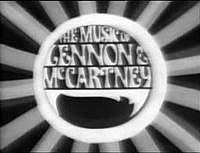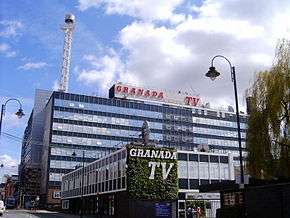The Music of Lennon & McCartney
The Music of Lennon & McCartney is a 1965 British television special honouring the Lennon–McCartney songwriting partnership of John Lennon and Paul McCartney of the English rock band the Beatles. It was produced by Granada Television and aired on that network on 16 December 1965 before receiving a national broadcast the following evening. The programme mainly consisted of other artists miming to their recordings of Lennon–McCartney songs,[3] interspersed with scripted commentary from Lennon and McCartney. In addition, the Beatles performed both sides of their current single, "Day Tripper" and "We Can Work It Out". Peter Sellers performed a comedic interpretation of "A Hard Day's Night", in the style of stage actor Laurence Olivier's portrayal of Richard III.
| The Music of Lennon & McCartney | |
|---|---|
 The opening title used for the special | |
| Directed by | Philip Casson[1] |
| Starring | John Lennon Paul McCartney George Harrison Ringo Starr Cilla Black Peter Sellers Marianne Faithfull |
| Country of origin | United Kingdom |
| Production | |
| Producer(s) | Johnnie Hamp |
| Running time | 44 minutes[2] |
| Release | |
| Original network | Independent Television |
| Original release | 16 December 1965 |
The special served as further recognition for the Beatles, particularly Lennon and McCartney, outside the usual parameters of pop music. It followed the band's appointment as Members of the British Empire in late October 1965 and led to a surge in the number of cover versions of Lennon–McCartney songs. The special was not shown again until December 1985, when it aired as part of Channel 4's celebration of 30 years of Granada Television.
Background and filming
The Music of Lennon & McCartney was a project initiated by Johnnie Hamp,[4] who had championed the Beatles on Granada Television in 1962, a year before the band achieved national fame. Hamp intended the 1965 special to be a tribute to the Lennon–McCartney songwriting partnership. Negotiations to ensure the Beatles' participation were held for two months.[5] The format was a variety special.[6] Paul McCartney later said that the show "wasn't really our thing", and that he and John Lennon only agreed to participate out of loyalty towards Hamp.[7] While the band committed to the Granada project, they turned down an invitation to perform at the Royal Variety Show and refused to reprise the Beatles Christmas Shows they had held over the 1963–64 and 1964–65 holiday seasons.[6]

Filming took place at Granada's studios in Manchester on 1–2 November 1965.[8][9] The Beatles interrupted the recording sessions for their album Rubber Soul, which they were under pressure to complete for a pre-Christmas release, in order to appear on the program.[10] Lennon and McCartney's contributions included delivering the scripted links between other artists' performances of their songs. George Harrison and Ringo Starr joined their bandmates to film mimed performances[6] of both sides of the Beatles' forthcoming single, "Day Tripper" and "We Can Work It Out".[11] The set design featured scaffolding around the walls, and steps and ladders.[11] The harmonium played by Lennon during "We Can Work It Out" was the same instrument seen in Granada's popular soap opera Coronation Street.[12] The Pamela Devis Dancers provided the choreography for some of the musical segments.[13]
Peter Sellers filmed his contribution in advance at a studio in London,[11] due to his other film commitments. The Beatles admired R&B singer Esther Phillips and had her flown over from America to give her first performances in the UK.[14]
Programme content
All information per John Winn's book Way Beyond Compare: The Beatles' Recorded Legacy, Volume One, 1962–1965,[15] unless otherwise noted.
Part 1
- The George Martin Orchestra, medley including "I Feel Fine" – ends with a cut to Lennon and McCartney playing a cymbal with drumsticks
- Peter and Gordon, "A World Without Love" – introduced by Lennon and McCartney after the pair have listened to some cover versions of their songs played on set props such as a Victrola, a reel-to-reel tape machine, and a transistor radio
- Lulu, "I Saw Him Standing There"
- Alan Haven and Tony Crombie,[12] "A Hard Day's Night"
- Fritz Spiegl's Barock and Roll Ensemble,[16] medley including "She Loves You" – introduced by Lennon and McCartney; the ensemble members wear Baroque-era costumes and powdered wigs, and are surrounded by a crowd of women dressed in contemporary Mod fashions
- The Beatles, "Day Tripper" – accompanied by a group of go-go dancers
Part 2
- Paul McCartney/Marianne Faithfull, "Yesterday" – starts with McCartney miming to the Beatles' 1965 track and cuts abruptly, at the start of the second verse, to Faithfull miming to her recent recording, which she sings in a different key[17][nb 1]
- Antonio Vargas, "She Loves You" – preceded by Lennon and McCartney walking around the set while they discuss foreign-language interpretations of their songs
- Dick Rivers, "Ces Mots Qu'on Oublie un Jour (Things We Said Today)"
- Billy J. Kramer & the Dakotas, "Bad to Me"
- Cilla Black, "It's for You"
Part 3
- The George Martin Orchestra, "Ringo's Theme (This Boy)" – accompanied by a group of go-go dancers
- Henry Mancini, "If I Fell – introduced by McCartney
- Esther Phillips, "And I Love Him" – introduced by Lennon
- Peter Sellers, "A Hard Day's Night"
- The Beatles, "We Can Work It Out"
Broadcast
.jpg)
Melody Maker announced the TV special, along with the imminent release of "Day Tripper" / "We Can Work It Out" and Rubber Soul, and the dates for the band's 1965 UK tour, on the front page of its 4 December issue.[20] The special aired on the Granada network in the north of England between 9.40 and 10.35 pm on 16 December,[11] and then received a nationwide broadcast on ITV on 17 December.[21] It was the only television appearance the Beatles made in conjunction with the release of their new music, as promotional films for "Day Tripper" and "We Can Work It Out" were used to promote the single on Top of the Pops and other TV shows.[22] At the time, Lennon said of his and McCartney's songs: "There are only about a hundred people in the world who really understand what our music is all about. Ringo, George, and a few others scattered around the globe … The reason so many people use our numbers and add nothing at all to them is that they do not understand the music. Consequently they make a mess of it."[23]
The recognition afforded the Lennon–McCartney partnership followed BBC Radio's Songwriters programme on the pair's achievements,[16] while Mike Hennessey, writing in the same issue of Melody Maker, said the Beatles were "a pop music phenomenon which may very well never recur on such a monumental scale", adding: "But unquestionably the biggest single factor in their unprecedented success is the superb songwriting partnership of John Lennon and Paul McCartney."[24] In his book 1965: The Making of Modern Britain, Christopher Bray writes that such was the band's ascendancy that year, the Beatles were "everywhere", as not only leaders of a "new aristocracy" but also recipients of MBEs. The latter was an unprecedented appointment for pop stars at the time and a reflection of British politicians' recognition of the Beatles' influence and mass appeal.[25] Combined with the critical and public acclaim given to Rubber Soul, the show resulted in a surge in cover recordings of works from the Beatles' Northern Songs publishing catalogue. In author Bob Spitz's description: "By mid-1966, an astounding eighty-eight Lennon–McCartney songs had been recorded in over 2,900 versions. Gershwin finally had competition."[26]
The Music of Lennon & McCartney was not aired again until 30 December 1985. It was shown on Channel 4 as part of an evening of programmes recognising 30 years of Granada Television.[27] Due to this broadcast, the programme began circulating among bootleg collectors for the first time.[28] The "Day Tripper" segment was included in the Beatles 1+ CD and DVD set, released in November 2015.[12][29]
Among Beatles biographers, John Winn describes the Granada special as a "semisuccessful attempt to spotlight John and Paul's songwriting abilities". He says that the pair's "scripted banter is delivered awkwardly" and "neither are comfortable with the whole idea of the show, let alone the corny manner in which they are participating."[11][nb 2] Hunter Davies similarly finds Lennon and McCartney's spoken contributions "corny", although he gives the programme a score of seven out of ten with the assessment: "Great tribute show, with two fine Beatles performances as well."[12] Rolling Stone critic Rob Sheffield recognises Sellers' segment as an "offbeat highlight" in which the comedian renders "the lyrics as a Shakesperean monologue … making them sound even filthier".[30]
Notes
- A friend of McCartney through her artist husband John Dunbar,[18] Faithfull was eight months pregnant and was filmed only from the shoulders up.[19]
- In Winn's description, the clear admiration for Esther Phillips evident in Lennon's introduction marked the sole example of sincerity in the two Beatles' otherwise embarrassed delivery of their dialogue.[11]
References
- Womack, Kenneth (2014). The Beatles Encyclopedia: Everything Fab Four. Santa Barbara, CA: ABC-CLIO. p. 653. ISBN 978-0-313-39171-2.CS1 maint: ref=harv (link)
- Winn, John C. (2008). Way Beyond Compare: The Beatles' Recorded Legacy, Volume One, 1962–1965. New York, NY: Three Rivers Press. p. 372. ISBN 978-0-307-45239-9.CS1 maint: ref=harv (link)
- Everett, Walter (2001). The Beatles as Musicians: The Quarry Men through Rubber Soul. New York, NY: Oxford University Press. p. 335. ISBN 0-19-514105-9.CS1 maint: ref=harv (link)
- Harry, Bill. "The Early Beatles [cont.]". triumphpc.com/Mersey Beat. Retrieved 7 July 2018.
- Davies, Hunter (2016). The Beatles Book. London: Ebury Press. ISBN 978-0091958619.CS1 maint: ref=harv (link)
- Everett 2001, p. 335.
- The Beatles (2000). The Beatles Anthology. San Francisco, CA: Chronicle Books. p. 198. ISBN 0-8118-2684-8.CS1 maint: ref=harv (link)
- Miles, Barry (2001). The Beatles Diary Volume 1: The Beatles Years. London: Omnibus Press. pp. 213–14. ISBN 0-7119-8308-9.CS1 maint: ref=harv (link)
- Lewisohn, Mark (2005) [1988]. The Complete Beatles Recording Sessions: The Official Story of the Abbey Road Years 1962–1970. London: Bounty Books. p. 66. ISBN 978-0-7537-2545-0.CS1 maint: ref=harv (link)
- Lewisohn 2005, pp. 66–67.
- Winn 2008, p. 371.
- Davies 2016.
- "Pop and Music Television 1965–1969". Sixties City. Archived from the original on 8 July 2018. Retrieved 8 July 2018.
- Huey, Steve. "Esther Phillips". AllMusic. Retrieved 7 July 2018.
- Winn 2008, pp. 371–72.
- Womack 2014, p. 653.
- Everett 2001, p. 412.
- MacDonald, Ian (1998). Revolution in the Head: The Beatles' Records and the Sixties. London: Pimlico. p. 140fn. ISBN 978-0-7126-6697-8.
- Hodkinson, Mark (2010). Marianne Faithfull: As Years Go By. London: Omnibus Press. ISBN 978-0-857129932.CS1 maint: ref=harv (link)
- "Beatles Bounce Back – tour, TV, single, LP!". Melody Maker. 4 December 1965. p. 1.
- Womack, Kenneth (2017). Maximum Volume: The Life of Beatles Producer George Martin – The Early Years, 1926–1966. Chicago, IL: Chicago Review Press. p. 309. ISBN 978-1-613731895.CS1 maint: ref=harv (link)
- Miles 2001, pp. 215, 220.
- Miles 2001, p. 220.
- Hennessey, Mike (4 December 1965). "Sing Me a Beatle Song". Melody Maker. pp. colour sect. 1–2.
- Bray, Christopher (2014). 1965: The Year Modern Britain Was Born. London: Simon & Schuster. pp. 263–64. ISBN 978-1-84983-387-5.CS1 maint: ref=harv (link)
- Spitz, Bob (2005). The Beatles: The Biography. New York, NY: Little, Brown and Company. p. 595. ISBN 1-84513-160-6.
- Badman, Keith (2001). The Beatles Diary Volume 2: After the Break-Up 1970–2001. London: Omnibus Press. p. 363. ISBN 978-0-7119-8307-6.
- Winn 2008, p. 372.
- Rowe, Matt (18 September 2015). "The Beatles 1 To Be Reissued With New Audio Remixes ... And Videos". The Morton Report. Retrieved 8 July 2018.
- Sheffield, Rob (2017). Dreaming the Beatles: The Love Story of One Band and the Whole World. New York, NY: HarperCollins. p. 93. ISBN 978-0-06-220765-4.